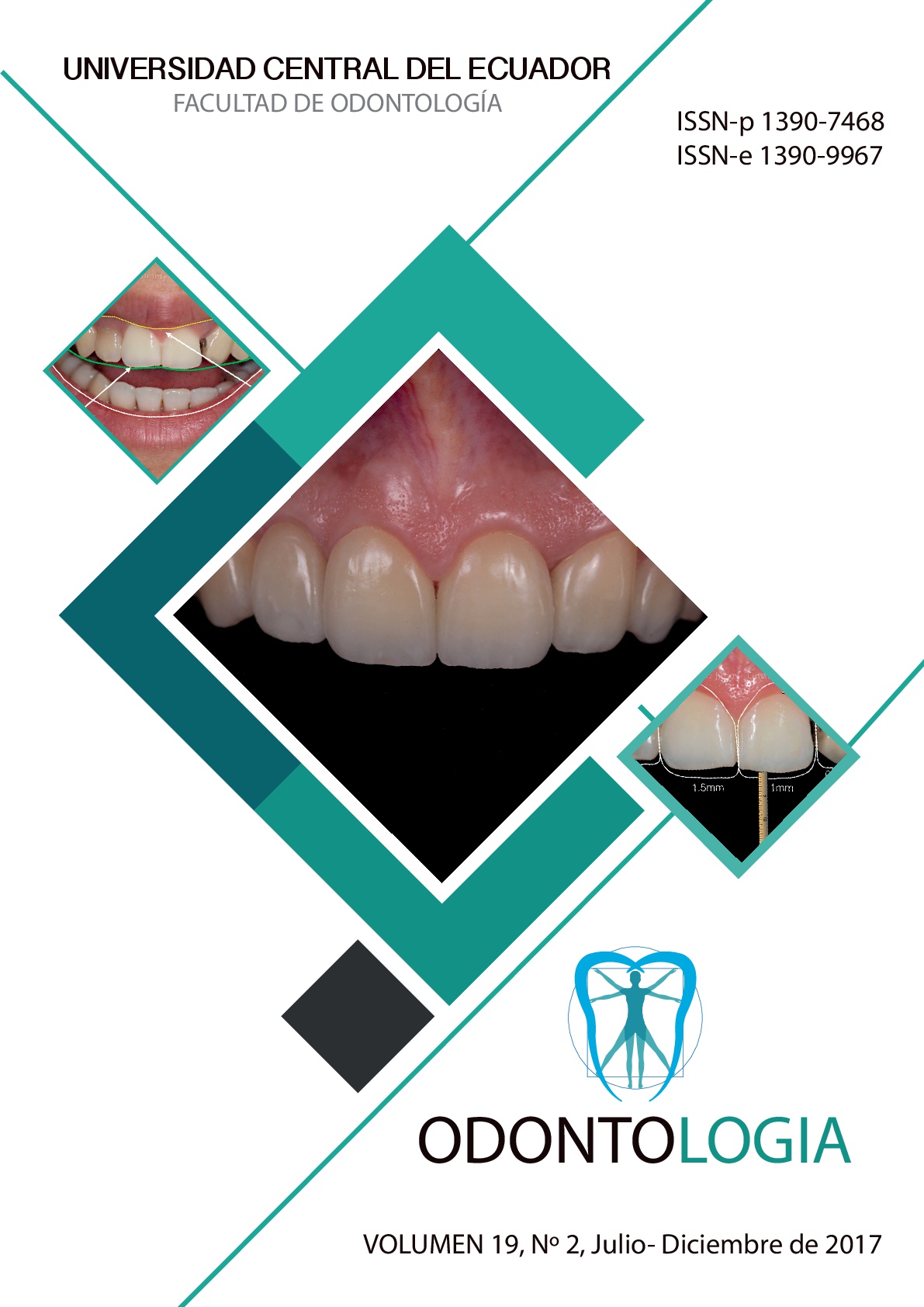Aesthetic alternatives for lateral incisor agenesia as part of an integral oral rehabilitation
DOI:
https://doi.org/10.29166//odontología.vol19.n2.53-73Keywords:
Anodontia, Dental Aesthetics, SmileAbstract
Nowadays aesthetic restorative tratments have accuried a main importance in dental clinics, because of the importance that patients give to their smile as a factor that helps thems to improve their self steem and life quality.
Female patient aged 39 years old, comes for consultation wishing to improve her smile, having recived a prior treatment that didnt satisfy her. Clinical examination revealed agenesia of tooth 22 and in its place a canine with a defective metal ceramic crown was found, spacing between teeth 23 and 21, atrition on teeth 11 and 21, discromia of tooth 12 and dental asimmetry of upper front teeth. The objective of this case report is to describe a rigurous dentofacial analisys which allows to obtain a precisse diagnosis and stablish a integral treatment plan (Funtional, Biological and Aesthetical) transforming the canine to lateral incisor and im-proving the patients smile.
Downloads
References
Gomes RR, da Fonseca JA, Paula LM, Faber J, Acevedo AC. Prevalence of hy-podontia in orthodontic patients in Brasilia, Brazil. Eur J Orthod. 2010; 32(3): 302-6.
Miller WB, McLendon WJ, Hines FB 3rd. Two treatment approaches for missing or peg-shaped maxillary lateral incisors: a case study on identical twins. Am J Orthod Dentofacial Orthop. 1987;92(3):249-56.
Schmitz JH, Coffano R, Bruschi A. Re-storative and orthodontic treatment of maxillary peg incisors: a clinical report. J Prosthet Dent. 2001; 85(4):330-4.
Izgi AD, Ayna E. Direct restorative treatment of peg-shaped maxillary lateral incisors with resin composite: a clinical report. J Prosthet Dent. 2005; 93(6): 526-9.
Ittipuriphat I, Leevailoj C. Anterior space management: interdisci- plinary concepts. J Esthet Restor Dent. 2013; 25(1): 16:30.
Oliveira OMS, Pallos D, Gil F, Cortelli Jr. Prevalencia de Hipodontie alteraçoes da anatomia dentária relacionadas. Rev Biociên. 2001;7(2):31-7.
Wu CCL, Wong RWK, Haga U. Areview of hipodontie: the possible etiologies and orthodontic, surgical and restorative treatment options- conventional and futuristic. Hong Kong Dent J. 2007;4(2):113-21
Paradowska A, SzelagJ, Kawala B. Hi-podontia in permanent dentition in pa-tients with unilateral cleft lip and palate. Dent Med Probl. 2009;46 (3):342-5
Boselli G, Pascotto RC. Incisivos laterales conoides: diagnóstico, planificación y tratamiento restaurador directo. Red Dent Press Estética. (2): 111-7.
Fradeani Mauro, Barducci Giancarlo, Corrado Marcantonio. Rehabilitación Esté-tica en Prostodoncia Fija. Editorial Quin-tessence, SL (1):21-268
Sidney K, Bruguera August, Invisible Restauraciones Estéticas Cerámicas. Artes Medicas Dental Press Editora 2007.(2): 31-68
Okenson Jeffrey P. Tratamiento de Oclusión y Afecciones Temporomandibu-lares.Elaevier 2013. (1) 21-99
Coachman Ch, Van Dooren E, Gürel G, Landsberg CJ, Cala- mita MA, Bichacho N. Smile design: From digital treatment planning to clinical reality. In: Cohen M (ed). Interdiscipli- nary Treatment Plan-ning. Vol 2: Comprehensive Case Studies. Chicago: Quintessence, 2012.
Magne P, Cascione D. In uen- ce of post-etching cleaning and connecting porcelain on the microtensile bond strength of composite resin to feldspathic porcelain. J Prosthet Dent. 2006 Nov;96(5): 354-61.


